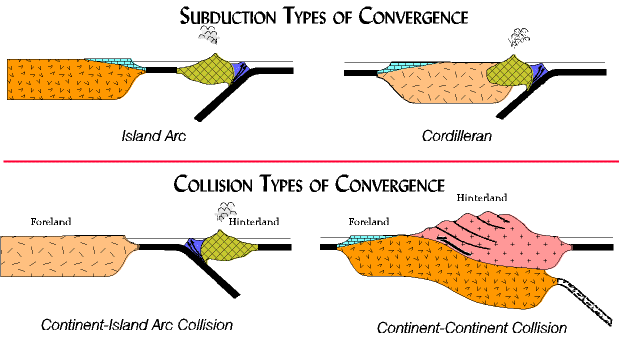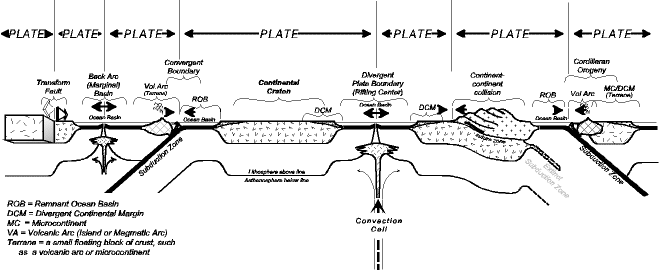Note the continental craton (stable continent) in the middle of the drawing. Note the line under the craton; that is the lower boundary of the lithosphere, and is the bottom boundary of the plate. Everything above that line is the plate. All similar lines in the cross section mark the bottom of the plates. Technically, everything above that line is lithosphere, the rigid, brittle shell of the earth. Everything below is asthenosphere, the hot, plastic interior of the earth with convection cells bringing heat to the surface from the earth's hot core.
Within the asthenosphere are convection cells, slowly turning over hot, plastic rock. The convection cells bring heat from the earth's interior out to the surface, but slowly. Movement is about 10 centimeters a year. When the convection cells reach the base of the lithosphere they release heat to the surface at the divergent plate boundary in the form of volcanos to escape to space. The cooled plastic rock then turns sideways and moves parallel to the earth's surface before descending back into the earth at subduction zones to become reheated. It is this turning over of the convection cells the drives the plate movements.
THE PLATES
Simplistically, the earth consists of plates, and plate boundaries, those zones where the plates contact and interact. Everything between plate boundaries are part of some plate. A look at the plate boundaries in the drawing may make plate boundaries appear confusing, but in fact there are only 3 kinds of plate boundaries.
Observe that 7 different plates are labeled in the cross section. Plates are combinations of two units, continents and ocean basins. Plates are composed either of a fragment of ocean basin, or (more commonly) a fragment of ocean basin with an attached continent.
It might be possible for a plate to be a continent alone, but for this to occur all edges of the continent would have to be a plate boundary (very rare, perhaps not practically possible). Note that in the cross section several different ocean basin/continent combinations are present, but that it is difficult to get a continent surrounded on all edges by plate boundaries.
PLATE BOUNDARIES
The three kinds of plate boundaries are also illustrated in the cross section, divergent, convergent, and transform. Plates interact at these boundaries.
Two divergent margins (plate boundaries) are present in the cross section: one labeled as such to the right of the continental craton, and the other on the left side. The left divergent margin is labeled Back Arc (Marginal) Basin. Back arc basins are formed by minor convection cells above subduction zones. Divergent plate boundaries always create new ocean floor (that is, new mafic oceanic lithosphere, called the ophiolite suite) when magma oozes into the crack as plates separate. The implication is, ocean basins get larger at divergent plate boundaries. But, since the earth cannot get larger it means ocean floor must be disappearing somewhere else.
Three convergent boundaries are present, all of them one way or another involving a subduction zone. The two most obvious ones are on the far right, and near the far left. Oceanic lithosphere is descending into the earth's mantle at these places, and being destroyed.
In the continent-continent collision the subduction zone is now extinct but can be seen below the surface.
Before the continents collided they were separated by an ocean basin, now completely subducted. Subduction zones generate lots of igneous magma that rises to the surface to form volcanic mountains (volcanic arcs; also island arcs, such as the islands of Japan, or Sumatra, or the Aleutian islands off Alaska). The igneous batholiths that feed the volcanoes are the beginning of generation of new continental crust. Continents are created above subduction zones as small proto- and microcontinents. They enlarge by colliding and fusing together, or suturing onto a larger continent, at a convergent plate boundary.
At convergent boundaries oceanic lithosphere is always destroyed by descending into a subduction zone. This is because oceanic rock is mafic, and heavy compared to the continents, and sinks easily. Because oceanic lithosphere is created and destroyed so easily ocean basins are young; the oldest we have is only about 200 million years old. Continents, on the other hand, composed of light weight rock never subduct. Thus, continental rock once formed is more or less permanent; the oldest continental fragment is 3.96 billion years old, virtually as old as the earth itself.
Only one transform boundary is present, on the left side of the drawing. At transform boundaries two plates just slide past one another horizontally, and quietly compared to convergent and divergent plate boundaries. Most of these are found in the ocean basins, but the San Andreas fault in California and Mexico is an example coming on land (and to California residents it probably does not seem that quiet).
THE SIX LITHOSPHERIC TECTONIC REGIMES
We can simplify the way we think about the structure of the lithosphere by realizing that there are only 6 tectonic regimes that make up the lithosphere. A tectonic regime is a portion of the earth that is more or less uniform in its structure, rock composition, and processes. The six tectonic regimes are the individual components that interact in plate tectonic theory. They can be grouped into three divisions.
1. Continents (or, cratons)
2. Ocean Basins
Divisions that compose the plates. These tend to be big and boring; geologically very little of interest happens within plates.
Plate Boundaries- the three ways plates meet and interact. These areas tend to be long, and linear or gently curved areas that are very unstable.
3. Divergent
4. Convergent
5. Transform
6. Hot Spots - pretty much do their own thing separate from everything else.
Each of these tectonic regimes is described in the Glossary.
PLATE COLLISIONS
The essence of plate tectonic theory is that the plates (ocean basins plus or minus continents) slide around over the earth's surface, interacting as they do at the plate boundaries. Thus, any time there is a divergent plate boundary where two plates are separating, there must be a convergent plate boundary (subduction zone) where two (or more) places come together again. And convergent boundaries always, eventually, lead to collisions between continents, or continents and terranes (island arcs plus or minus microcontinents).
The drawings below show the major types of collisions within plate tectonic theory, although any plausible combination of collisions is possible, and has probably happened in the past. Observe, however, that the only way to get a collision type orogeny is to first have a subduction type first.

Observe the subduction zones in the cross section at the top of the page (or larger version). Next to each one is a remnant ocean basin (ROB). An ROB is one that is disappearing down a subduction zone; it is a remnant of its former self. But all subduction zones must eventually disappear completely and when they do the floating blocks on either side will collide, and create a mountain range. The continent-continent collision in the cross section is a case where the collision has already occurred.
But in the larger picture, it is common for a divergent plate boundary to come into existence and create a new ocean basin, and then for that ocean basin to close again along a convergent plate boundary until two continents collide. This opening and closing of ocean basins is, of course, the supercontinent cycle . But it is also the Wilson Cycle, and is the simplest model we have of how the earth operates historically.
